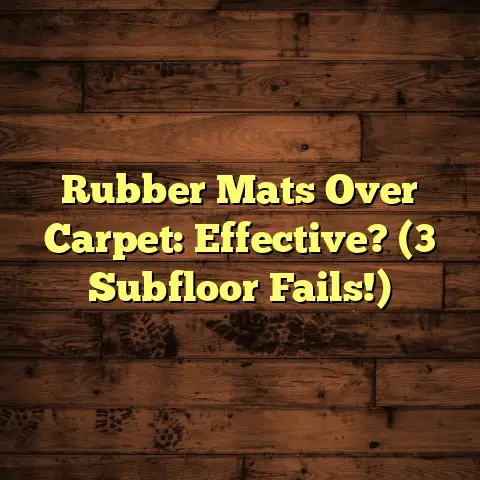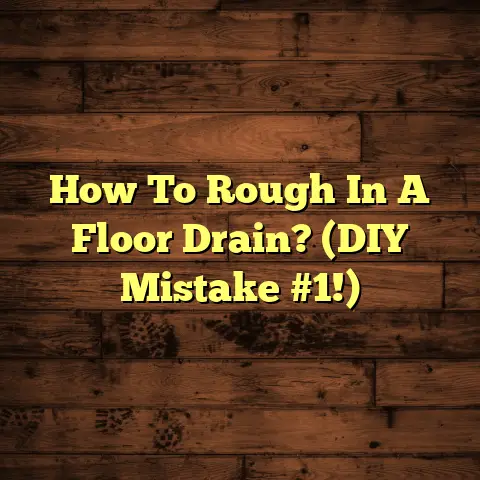Prep Concrete for Carpet Tiles? (9 Prep Steps Needed!)
Ever tried slapping carpet tiles directly onto a concrete floor, thinking it’s a quick and easy job?
I’ve seen it happen way too many times, and trust me, the results aren’t pretty.
Uneven surfaces, moisture bubbling up, and adhesives failing – it’s a recipe for disaster that can cost you time, money, and a whole lot of frustration.
That’s why proper preparation is absolutely key to a successful, durable, and gorgeous carpet tile installation.
Think of it as laying the foundation for success – literally!
In this article, I’m going to walk you through the nine essential steps needed to prep concrete for carpet tiles like a pro.
I’ll share my own experiences, industry insights, and some specialized data to help you avoid common pitfalls and achieve a flawless finish.
Ready to get started? Let’s dive in!
Section 1: Understanding the Importance
of Concrete Preparation
So, what exactly does “concrete preparation” entail?
It’s more than just sweeping the floor, my friends.
It’s a comprehensive process of assessing, cleaning, repairing, and leveling the concrete surface to create the ideal foundation for your carpet tiles.
Think of it like this: you wouldn’t build a house on a shaky foundation, right?
The same principle applies to flooring.
Neglecting proper prep work can lead to a whole host of problems:
-
Increased Costs: Premature wear and tear on your carpet tiles means you’ll be replacing them sooner than expected.
-
Installation Time: Trying to work with an uneven or dirty surface will slow you down and make the installation process much more difficult.
-
Potential Damage: Moisture issues can lead to mold growth, which can damage both your flooring and your health.
But here’s the good news: thorough preparation offers a ton of benefits:
-
Improved Durability: A properly prepared surface ensures that your carpet tiles will last longer and withstand heavy foot traffic.
-
Enhanced Appearance: A level surface means your carpet tiles will lay flat and look their best.
-
Better Overall Performance: Proper adhesion prevents tiles from shifting or peeling up, ensuring a safe and comfortable walking surface.
Section 2: Step 1 – Assess the Condition
of the Concrete
Alright, let’s get our hands dirty!
The first step is to thoroughly assess the condition of your concrete surface.
This involves a visual inspection and some moisture testing.
Visual Inspection:
-
Cracks: Look for any cracks, large or small. Even hairline cracks can be a sign of underlying issues.
-
Chips: Check for chips and spalling (where the surface of the concrete is flaking off).
-
Imperfections: Note any other imperfections, such as stains, gouges, or uneven areas.
Moisture Assessment:
Moisture is the enemy of carpet tile installation.
Excess moisture can lead to adhesive failure, mold growth, and a host of other problems.
Here’s how to test for moisture:
-
Plastic Sheet Test: Tape a 2×2 foot square of clear plastic sheeting to the concrete floor. Seal all the edges with duct tape.
Wait 24-48 hours and then check for condensation under the plastic.
If you see condensation, it indicates a moisture problem.
-
Moisture Meter: A concrete moisture meter is a more accurate way to measure moisture levels. These meters use electrical resistance to determine the amount of moisture in the concrete.
- Acceptable moisture levels generally fall below 4.5% using a Tramex Concrete Moisture Encounter meter or below 75% RH using in-situ probes.
Suitability:
Based on your assessment, determine if the concrete is suitable for carpet tile installation.
If you find significant damage or high moisture levels, you’ll need to address these issues before proceeding.
Section 3: Step 2 – Clean the Concrete Surface
Now that you’ve assessed the concrete, it’s time to clean it!
A clean surface is essential for proper adhesion.
Tools and Materials:
- Shop vacuum
- Scraper
- Stiff-bristled brush
- Concrete cleaner or degreaser
- Mop and bucket
Removal:
Start by removing any loose debris, dust, and dirt with a shop vacuum.
Use a scraper to remove any stubborn residue, such as old adhesive or paint.
Cleaning:
Next, apply a concrete cleaner or degreaser to the surface.
Follow the manufacturer’s instructions for dilution and application.
Use a stiff-bristled brush to scrub the surface thoroughly.
Pay close attention to areas with grease or stains.
Rinsing:
Rinse the surface with clean water and allow it to dry completely.
This may take several hours, depending on the humidity and temperature.
Section 4: Step 3 – Repair Any Damage
Time to fix those imperfections!
Repairing cracks and uneven areas is crucial for creating a smooth, level surface.
Types of Damage:
-
Cracks: Cracks can range from hairline fractures to large, gaping fissures.
-
Uneven Areas: Uneven areas can be caused by settling, damage, or poor initial construction.
Materials:
- Concrete patching compound
- Trowel
- Mixing bucket
- Water
Repairing Cracks:
-
Widen the crack slightly with a chisel or crack chaser to create a better bonding surface.
-
Clean out any loose debris from the crack.
-
Mix the concrete patching compound according to the manufacturer’s instructions.
-
Apply the patching compound to the crack, using a trowel to smooth it out.
-
Allow the patching compound to dry and cure completely before proceeding.
Repairing Uneven Areas:
-
Apply a thin layer of concrete patching compound to the low areas.
-
Use a trowel to feather the edges of the patching compound, creating a smooth transition to the surrounding concrete.
-
Allow the patching compound to dry and cure completely before proceeding.
Drying and Curing:
It’s essential to allow the repairs to dry and cure completely before moving on to the next step.
Follow the manufacturer’s instructions for drying and curing times.
This may take several days, depending on the product and environmental conditions.
Section 5: Step 4 – Level the Surface
A level surface is non-negotiable for a professional-looking carpet tile installation.
Even slight variations in height can cause tiles to shift, peel up, or create an uneven walking surface.
Methods for Leveling:
-
Self-Leveling Compound: Self-leveling compound is a liquid mixture that flows easily and levels itself out. It’s ideal for correcting larger imperfections and creating a perfectly level surface.
-
Screeding: Screeding involves using a long, straight edge (called a screed) to level a layer of concrete or patching compound. It’s best for smaller areas or for creating a specific slope.
Self-Leveling Compound:
-
Prepare the concrete surface by cleaning it thoroughly and priming it with a concrete primer.
-
Mix the self-leveling compound according to the manufacturer’s instructions.
-
Pour the compound onto the floor and allow it to flow and level itself out.
-
Use a gauge rake to help distribute the compound evenly.
-
Allow the compound to dry and cure completely before proceeding.
Checking for Flatness and Levelness:
After applying the leveling solution, it’s important to check for flatness and levelness.
Use a long level or a straight edge to check for any high or low spots.
If you find any imperfections, you may need to apply another layer of leveling compound or use a grinder to smooth them out.
Section 6: Step 5 – Moisture Testing
I can’t stress enough how crucial moisture testing is.
Even if you didn’t see condensation during your initial assessment, it’s still important to conduct thorough moisture tests before installing carpet tiles.
Moisture Tests:
-
Moisture Meter: Use a concrete moisture meter to measure the moisture content of the concrete.
Insert the probes into the concrete and record the readings.
-
Calcium Chloride Test: This test involves placing a container of calcium chloride on the concrete surface and measuring the amount of moisture it absorbs over a period of time.
This test is more accurate than the plastic sheet test but requires more time and specialized equipment.
Acceptable Levels:
Acceptable moisture levels for carpet tile installation vary depending on the manufacturer’s recommendations and the type of adhesive you’re using.
Generally, you’ll want to see moisture levels below 4.5% using a Tramex Concrete Moisture Encounter meter or below 75% RH using in-situ probes.
Mitigation Strategies:
If moisture levels are too high, you’ll need to implement moisture mitigation strategies.
-
Vapor Barriers: Apply a vapor barrier to the concrete surface to prevent moisture from rising through the floor.
-
Sealers: Use a concrete sealer to seal the surface and prevent moisture from penetrating the concrete.
Section 7: Step 6 – Priming the Concrete
Priming is like applying a makeup primer – it creates a smooth, even surface for the adhesive to bond to.
Role of Primer:
-
Improves Adhesion: Primer creates a stronger bond between the concrete and the adhesive.
-
Seals the Surface: Primer seals the concrete surface, preventing the adhesive from being absorbed into the concrete.
-
Reduces Dust: Primer helps to reduce dust and debris, creating a cleaner surface for installation.
Types of Primers:
-
Acrylic Primers: Acrylic primers are water-based and easy to apply. They’re suitable for most concrete surfaces.
-
Epoxy Primers: Epoxy primers are more durable and offer better moisture resistance. They’re ideal for areas with high moisture levels.
Application:
-
Make sure the concrete surface is clean, dry, and free of any loose debris.
-
Apply the primer evenly to the concrete surface using a roller or brush.
-
Allow the primer to dry completely before proceeding.
Follow the manufacturer’s instructions for drying times.
Section 8: Step 7 – Choosing the Right Adhesive
Choosing the right adhesive is just as important as prepping the concrete.
The wrong adhesive can lead to tiles shifting, peeling up, or failing to bond properly.
Types of Adhesives:
-
Pressure-Sensitive Adhesive (PSA): PSA is a type of adhesive that forms a bond when pressure is applied. It’s easy to use and offers good initial tack.
-
Wet-Set Adhesive: Wet-set adhesive is applied to the concrete and allowed to become tacky before the tiles are installed. It provides a stronger bond than PSA and is ideal for high-traffic areas.
Choosing the Right Adhesive:
Consider these factors when choosing an adhesive:
-
Type of Carpet Tiles: Different carpet tiles require different types of adhesives. Check the manufacturer’s recommendations for the best adhesive to use with your specific tiles.
-
Environmental Conditions: Consider the temperature and humidity of the installation area. Some adhesives are more sensitive to environmental conditions than others.
-
Moisture Levels: If you have high moisture levels in your concrete, choose an adhesive that is designed for moisture resistance.
Following Recommendations:
Always follow the manufacturer’s recommendations for adhesive application.
This includes using the correct amount of adhesive, applying it in the correct pattern, and allowing it to cure properly.
Section 9: Step 8 – Acclimating Carpet Tiles
Acclimating carpet tiles is like letting them adjust to their new home.
It helps them to expand or contract to the ambient temperature and humidity, preventing them from shifting or buckling after installation.
Necessity:
Acclimating carpet tiles is essential for a successful installation.
If you skip this step, you risk the tiles expanding or contracting after they’re installed, which can lead to gaps, buckling, or adhesive failure.
Conditions:
Acclimate carpet tiles in the same room where they will be installed.
The temperature should be between 65°F and 75°F, and the humidity should be between 30% and 60%.
Timeline:
Allow the carpet tiles to acclimate for at least 48 hours before installation.
For best results, acclimate them for 72 hours or longer.
Section 10: Step 9 – Final Inspection
Before you start laying those carpet tiles, take one last look!
The final inspection is your chance to catch any mistakes or oversights before they become major problems.
Checklist:
-
Surface Cleanliness: Is the concrete surface clean and free of any dust, dirt, or debris?
-
Repairs: Have all cracks and uneven areas been properly repaired?
-
Levelness: Is the surface level and flat?
-
Moisture Levels: Are the moisture levels within acceptable limits?
-
Priming: Has the concrete surface been properly primed?
-
Adhesive: Have you chosen the right adhesive for your carpet tiles and environmental conditions?
-
Acclimation: Have the carpet tiles been properly acclimated?
Importance:
This final inspection is crucial for preventing future issues with your carpet tile installation.
By taking the time to verify that all steps have been completed adequately, you can ensure a long-lasting and beautiful flooring project.
Conclusion
So there you have it – the nine essential steps for prepping concrete for carpet tiles.
I know it seems like a lot of work, but trust me, it’s worth it!
Proper preparation is the key to a successful flooring project that will look great and last for years to come.
Take the time to follow each step diligently, and you’ll avoid common pitfalls and ensure a professional-quality installation.
Happy flooring!





